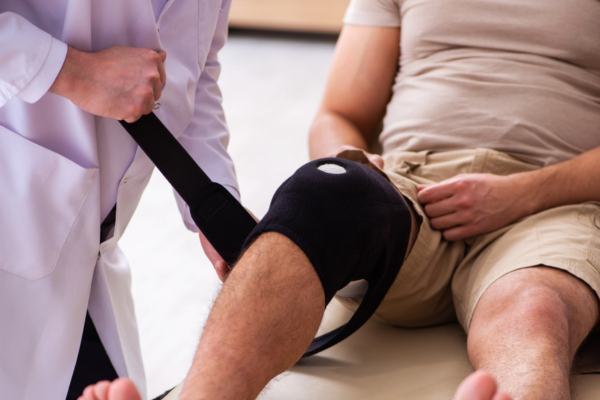Meniscal Repair
A meniscal repair is a surgical procedure to fix a torn meniscus in the knee. Unlike a meniscectomy (where part of the cartilage is removed), meniscal repair aims to preserve and heal the meniscus, helping to maintain long-term knee health and reduce the risk of arthritis.
This page explains when meniscal repair surgery is recommended, how the procedure works, and what recovery looks like.

What is the Meniscus?
The meniscus is a C-shaped piece of cartilage inside the knee joint that acts as a cushion between the thighbone (femur) and shinbone (tibia). Each knee has two menisci – one on the inner side (medial) and one on the outer side (lateral).
The meniscus distributes weight, absorbs shock, and stabilises the knee. Preserving it through repair rather than removal is often the best option for long-term knee function.
Causes of Meniscus Tears
Meniscus tears commonly occur due to:
- Twisting the knee while the foot is planted
- Sudden changes in direction during sport
- Deep squatting or kneeling
- Age-related degeneration (wear-and-tear tears)
Symptoms of a Meniscus Tear
Typical signs that may require surgery include:
- Pain along the joint line of the knee
- Swelling and stiffness
- Catching, locking, or clicking of the knee
- Limited movement and instability
Diagnosis of Meniscus Injuries
A consultant orthopaedic knee surgeon will usually recommend:
- Clinical examination (checking for joint tenderness and mobility)
- MRI scan to confirm the type and location of the tear
- X-rays to rule out other causes such as arthritis
Meniscal Repair vs Meniscectomy
- Meniscal Repair: The torn cartilage is stitched back together to encourage natural healing. This is preferred in younger patients, athletes, and where the tear is in a “healing zone” with good blood supply.
- Partial Meniscectomy: If repair is not possible, the damaged portion of the meniscus may be trimmed to relieve symptoms.
Preserving the meniscus wherever possible is strongly recommended for long-term knee health.
Meniscal Repair Surgery Explained
Before
- MRI to confirm repair suitability
- Pre-operative physiotherapy (“pre-hab”) to strengthen the muscles
- Discussion of surgical risks and recovery timelines
During
- Performed under a general anaesthetic
- Arthroscopic (keyhole) technique using small incisions
- Torn meniscus stitched using specialised sutures or anchors
- Procedure typically takes under one hour
After
- Most patients return home the same day
- Crutches provided for support
- Early physiotherapy to restore motion and strength
Recovery After Meniscal Repair
Short-Term Recovery
- Crutches needed for 2–6 weeks depending on the type of repair
- Gradual increase in weight-bearing as advised by your surgeon
Rehabilitation Timeline
- 0–6 weeks: Protect repair, gentle mobility exercises
- 6–12 weeks: Begin strengthening exercises
- 3–6 months: Gradual return to sport-specific activity
- 6–9 months: Full return to competitive sport in most cases
Recovery is slower than partial meniscectomy, but outcomes are better for joint preservation.

Risks and Complications
Meniscal repair is generally safe, but possible risks include:
- Infection
- Stiffness or reduced motion
- Blood clots (rare)
- Failure of repair, requiring further surgery
Why Choose Mr Mark Webb for Meniscal Repair?
When you choose Mr Mark Webb for your meniscal repair, you can expect:
-
A precise diagnosis using advanced imaging and arthroscopic techniques
-
A treatment plan personalised to your tear’s type, location, and your lifestyle
-
Access to the latest repair methods that preserve as much meniscal tissue as possible
-
A structured rehabilitation programme to protect the repair and help you recover safely
-
The best chance of reducing knee pain, restoring function, and preserving long-term knee health
Frequently Asked Questions
Can my meniscus tear heal by itself?
Small meniscus tears sometimes improve with rest, physiotherapy, and avoiding aggravating activities. However, many tears, especially those in areas with poor blood supply or those that cause locking or instability, will not heal fully without surgery.
How do I know if I’m a good candidate for meniscal repair instead of removal (partial meniscectomy)?
Factors that matter include where the tear is (tears in the outer edge of the meniscus with better blood supply heal better), how recent the injury is, the size and pattern of the tear, how stable your knee is, your age and overall health, and whether you’re willing/able to follow a rehab programme. HSS and other sources discuss how these factors affect the decision.
What is recovery like after meniscal repair, and how long will it take before I can return to full activity or sport?
Recovery is more involved than for removal of a torn portion. You’ll likely need crutches for several weeks, wear a brace, begin physical therapy fairly early but progress gradually. Full return to sports or very active living often takes 4–9 months depending on your tear, how well repair goes, and how strictly you follow rehab.
What are the risks or possible complications associated with meniscal repair?
Some risks include: repair not healing completely, re-tearing of the meniscus, stiffness, infection, or slower return to activity. Also, if the tear is in a low-blood supply area, the chance of failure is higher. Long-term risk: if the meniscus is removed rather than repaired, greater risk of cartilage wear or arthritis.
If I don’t have a meniscal repair, what happens? Will things get worse?
Without surgery, symptoms may persist: pain, swelling, catching or locking of the knee. Some untreated tears lead to more damage elsewhere in the knee (e.g. cartilage wear), which can lead to osteoarthritis. Conservative treatments may help, but may not fully restore function or stop long-term damage.

